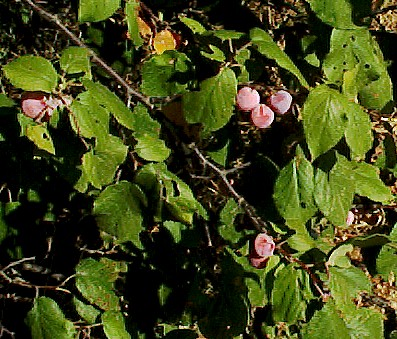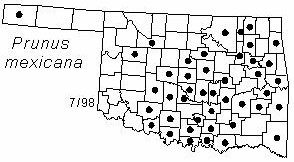
Shrub or small tree to 8 m (25 ft) tall. Crown irregular, open. Bark dark to black, roughly furrowed and peeling. Twigs gray-brown, pubescent when young, becoming glabrous with age. Leaves alternate, simple; ovate, elliptic, or obovate, 4.5-9 cm (1.8-3 .5 in) long and 2.5-5 cm (1-2 in) wide; reticulate veins above and below, glabrous above, hairy beneath (particulary on veins), yellow-green, shiny beneath; cuneate or rounded at base, acuminate at apex, margins singly or doubly serrate; petioles 1.5 cm (0.6 in) inch long, stout, pubescent. Flowers in umbels, glabrous with 2-4 flowers, 2-2.5 cm (0.8-1 in) in diameter; petals 5, white; styles 1; stamens 15-20; flowers appear from March to April. Fruits drupes, 3-3.5 cm (1.2-1.3 in), subglobose, dark purple-red; fruits mature matures July to September.
Distribution: Oklahoma, Texas, Missouri to Kentucky and Tennessee, south to northeastern Mexico. Common in Oklahoma.
Habitat: fencerows and woodlands.
Comments: Prunus is the classical name for European plums; mexicana refers to the southwestern distribution.
Field identification: American plum (Prunus americana) and Mexican plum can be easily confused. Mexican plum flowers later and does not form thickets.
Food uses: The fruits can be eaten raw or cooked. They are often prepared as jelly or preserves. Native Americans sun dried the plums for winter consumption, but not all tribes removed the pits first.
Wildlife benefits: The fruits of Mexican plum are eaten by several species of birds and mammals.
NWI status: none
Distribution in Oklahoma:

BACK
NEXT
RETURN TO INDEX
Last update: 9/15/99
 Go to Oklahoma Biological Survey Home Page
Go to Oklahoma Biological Survey Home Page
 Disclaimer
Disclaimer